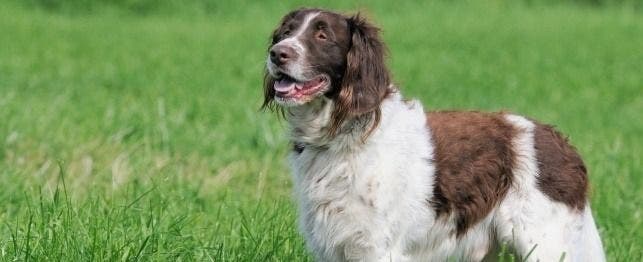
Choosing a Munsterlander
The Munsterlander is an excellent and loved hunting dog as well as wonderful companion. Though not recognized by the American Kennel Club, the Munsterlander is becoming more popular.
History and Origin
The Munsterlander comes in two separate sizes, each a separate breed. The small Munsterlander is not as common as the larger version and is rarely found outside northern Europe.
The large and small Munsterlanders were developed in Germany. It is thought that the large Munsterlander is a descendant of the German bird dogs, the black and white variation of the German longhaired pointer. The small Munsterlander is a close relative, just smaller in size. In the 1800s, generic German bird dogs were very popular hunting dogs because they were skilled in hunting, pointing and retrieving. Eventually, hunters decided to standardize the different types and breeds of dog. When the breed standard for the German longhair pointer was developed, it was decided that only the liver and white coloration was acceptable. Those pups born black and white were rejected but were favored among hunters. In 1919, those previously rejected black and white dogs were named the large Munsterlander and were designated as a breed separate from the German longhaired pointer.
Prior to beginning strict breeding programs, litters were born containing both German longhaired pointers and large Munsterlanders. Eventually, through diligent breeding programs, the breeds became separate. The small Munsterlander was bred to be a smaller version of the large Munsterlander and is considered a separate breed. The small Munsterlander is not as common as the large version so little is known about their history and breeding practices. This breed is rarely, if ever, seen outside northern Europe.
During World War II, the breeding program for the large Munsterlander was abandoned and the breed was almost lost. After the war ended, the breed was rescued. In 1966, the large Munsterlander was imported to North America. In 1972, the breed was brought to Great Britain, where their quality was greatly improved and dogs were then exported from England back to Europe to help strengthen the breeding stock.
In 1985, the large Munsterlander was recognized by the United Kennel Club, but has not yet been recognized by the American Kennel Club. The small Munsterlander is not recognized by either kennel club.
Appearance and Size
The large Munsterlander has a long, slightly rounded head that gives the impression of stability and dignity. The eyes are medium-sized and dark brown with an intelligent expression. The ears are flat and broad and lie close to the head. The body of the large Munsterlander is muscular and firm with a fully feathered longhaired tail. The coat is long, straight and dense. On the head, the coat is short and smooth and often solid black but there may be some white markings. The body is white or blue roan with black patches, flecked, ticked or a combination of these. The large Munsterlander stands 23 to 26 inches at the shoulder and weighs between 55 to 65 pounds.
The small Munsterlander looks very similar to the large Munsterlander except for their size and color. The small Munsterlander is dapple brown with white and the hair coat on the body is shorter than that of the large version. The breed looks very much like a springer spaniel. The small Munsterlander stands 20 to 22 inches at the shoulder and weighs 30 to 40 pounds.
Personality
The Munsterlander is a very affectionate, trustworthy and loyal dog. This breed is full of energy and has a keen sense of smell. When they find their quarry, they tend to bark. They are very intelligent and need plenty of mental stimulation and physical activity to prevent destructive behavior.
Home and Family Relations
The Munsterlander is an excellent gundog and companion. They are cuddly and soft dogs with a lot of patience for children. The Munsterlander loves to please his family and prefers to live in the home instead of in a kennel. They get along with other animals, but chickens and rabbits need to be watched carefully since the Munsterlander’s natural hunting instinct may overcome them.
Training
The Munsterlander is easily trained in obedience and as a gundog. Their goal is to please their owner and they work well on land or in the water. Their training can begin as a puppy but this breed takes a little longer than other breeds to fully mature so more aggressive training should be delayed until the dog is an adult.
The small Munsterlander is a little slow in the field but is very persistent. He is preferred by hunters that travel through rough and rugged terrain.
Grooming
The Munsterlander needs daily brushings to keep tangles, sticks, mud, and other foreign objects out of their coats.
Special Care
The Munsterlander does not require much special care. They do need to be brushed often to keep their coat clean and shiny. They require plenty of exercise to prevent boredom.
Common Diseases and Disorders
Gastric torsion (bloat) is a life-threatening sudden illness associated with the stomach filling with air and twisting.
Hip dysplasia is a malformation of the hip joint that results in pain, lameness and arthritis.
Entropion is a problem with the eyelid that causes inward rolling. Lashes on the edge of the eyelid irritate the surface of the eyeball and may lead to more serious problems.
The life span of the Munsterlander is 12 to 13 years.
We realize that each dog is unique and may display other characteristics. This profile provides generally accepted breed information only.